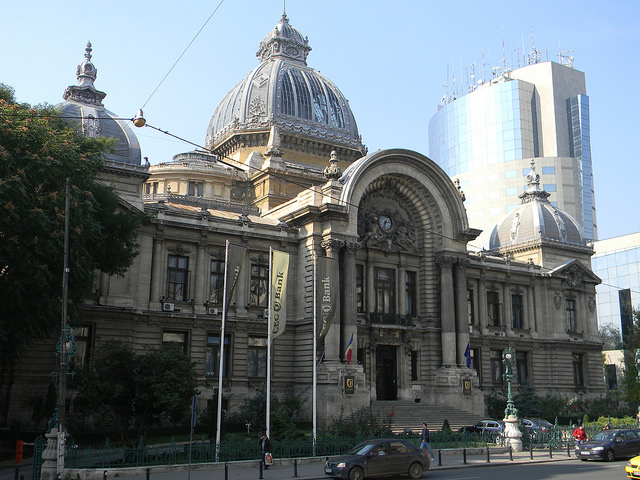The Savings’ Bank Palace in Bucharest
One of the emblematic buildings of mid 19th Century Bucharest

Christine Leșcu, 17.12.2016, 13:15
The ascension to the throne by Carol I, in mid 19th century, brought along not only a fast paced modernisation of society but also the transformation of several towns, Bucharest in particular. In only a few decades, until WWI, tall, imposing buildings emerged in Bucharest, most of them works by foreign and Romanian architects who had studied abroad, embracing the prevailing trends and styles of the time, imposed mainly by the Parisian chic taste.
One of the emblematic buildings of the time, which make you think of Paris, is the Savings Bank Palace, a landmark building of Bucharest, which still serves its initial function, that of housing the first Romanian bank. Situated on Calea Victoriei (Victory Road), close to the commercial centre near Lipscani Street, and the Dambovita River, the palace was built on an important site for the inhabitants of Bucharest, says historian Dan Falcan:
Dan Falcan: “This imposing palace was built on the site of the Sf Ioan cel Mare monastery. Construction works started officially on June 8, 1897, with King Carol I and Queen Elisabeth attending the event. It was a 300 years old church. A first church having St John as its patron saint was attested in documents as early as the 17th century, but it was restored by ruler Constantin Brâncoveanu between 1703 and 1705. It was a very beautiful church and today, fragments of it are put on show at the ‘Curtea Veche Museum. Unfortunately, after the restoration of 1705, the church started degrading and subsequently had to be demolished in 1875. The ‘Sf. Ioan cel Mare monastery and church owned large properties, stretching from Dambovitas Bank to todays ‘Cercul Militar building.
Since 1864, a wing of the monastery had been housing the Savings Bank, actually the first bank of the Romanian Principalities. It was set up under a decree issued by ruler Alexandru Ioan Cuza. The banks headquarters were later moved to the current Palace, on the initial site of the monastery. The project drawn up by architect Paul Gottereau was chosen for the building. Historian Dan Falcan has further details:
Dan Falcan: “Paul Gottereau was one of the official architects of the time. Many buildings in Bucharest were designed by him, and only the construction engineers differed. In the case of the Savings Bank Palace, the builder was Ion Socolescu. Among others, Paul Gottereau contributed to the refurbishment of the Royal Palace and the Cotroceni Palace. He was one of the foreign architects, mostly French, who came to Romania in the second half of the 19th century, alongside Theophile Bradeau, Albert Galleron and Swiss Louis Blanck. It is to them that Bucharest owes, at least to a certain extent, the nickname ‘Little Paris, as they came here and designed buildings just like they had been taught in the French capital city. Furthermore, all the Romanian architects active during that period of time, had studied in Paris and consequently built in the style they had learnt there. Due to that, Bucharest was called Little Paris, as the buildings erected between 1880 and 1914 were influenced by French architecture. Actually, the Savings Bank Palace is also reminiscent of Le Petit Palais in Paris. Paul Gottereau started its construction in 1897 and completed it in 1900. It is an imposing building, with an amazing semicircular fronton, above the entrance. It is supported by four pillars, and is built in the eclectic style. The two lateral cupolas were built in the Renaissance style. Although imposing, the palace is harmoniously built, being perfectly integrated in the environment. Opposite the Savings Bank Palace, there is the former Post Palace, which is now housing the national history museum, built in the same period, by architect Alexandru Săvulescu.
The interior of the Savings Bank Palace is just as spectacular, with a huge and richly decorated hall housing the counters. In 2005, the Savings Bank Museum was set up inside the building of the Savings Bank, designed by Paul Gottereau. The museum has a collection of objects which mark the evolution of that bank along the years: original documents of financial-banking transaction made in the early years of the bank, banking products since 1880 to the present day, “deposits and safes from the inter-war period, as well as promotional items used by the bank along the years- stamps, commemorative medals, badges, postal cards.






























